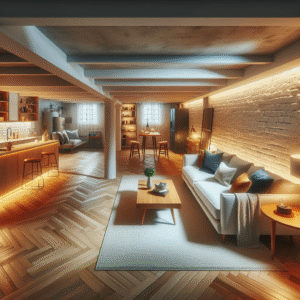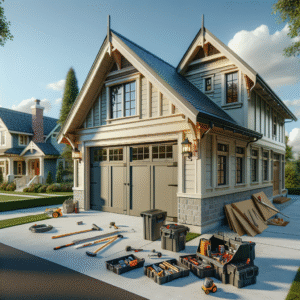Are you considering a switch to solar power for your home? You’re in good company! With the increasing awareness of environmental issues and the rising cost of traditional energy sources, many homeowners are turning to solar energy as a sustainable and cost-effective solution. In this comprehensive guide, we’ll explore everything you need to know about setting up a home solar power system, from the types of solar panels to the installation process, and even how to capitalize on financial incentives.
Understanding Solar Power System Basics
Before diving into the world of solar, it’s crucial to understand the basics. Solar power systems harness the sun’s energy and convert it into electricity for your home. Here’s a quick look at the essential components:
- Types of Solar Panels: There are mainly three types – Monocrystalline, Polycrystalline, and Thin Film. Each has its pros and cons regarding efficiency, cost, and installation.
- Key Components: Besides panels, a typical system includes inverters, batteries, and mounting systems, all crucial for the efficient functioning of solar power.
- Panel Efficiency and Placement: Maximizing solar energy output depends significantly on the efficiency of the panels and their strategic placement on your property.
Step-by-Step Guide to Installing a Home Solar Power System
Setting up a solar power system isn’t just about buying panels and installing them. It involves careful planning and consideration:
- Evaluating Your Home’s Solar Potential: Assessing your home’s location, roof condition, and sun exposure.
- Choosing the Right System: Based on your energy needs and budget.
- Detailed Installation Process: From conducting a site assessment to the final mounting of panels.
Cost Analysis and Incentives for Solar Installation
Understanding the financial aspects is just as important as the technical details:
- Investment vs. Savings: While the upfront costs can be substantial, the long-term savings on energy bills and increased home value can offset your initial investment.
- Federal and Local Incentives: Many governments offer tax breaks and subsidies to encourage solar adoption, which can significantly reduce costs.
- Choosing Contractors: Tips on finding reliable and certified professionals to ensure a smooth and efficient installation.
By harnessing solar energy, you’re not only saving money but also contributing to a greener planet. Let’s dive deeper into how you can make this beneficial switch!

If you’re ready to take your home improvement or construction project to the next level, we can help! Find trusted contractors on BuildNet, whether you’re looking for renovations, new builds, electrical work, plumbing, or anything in between. Our directory connects you with qualified professionals who can make your vision a reality.
Understanding Solar Power System Basics
Hey there! Considering making the leap to solar? You’re not alone! Many homeowners are turning to solar energy to reduce their carbon footprint and save on energy bills. Let’s dive into the basics of solar power systems, explore the different types of solar panels, and discuss other crucial components like inverters and batteries. By the end of this, you’ll have a clearer picture of how solar power can light up your home efficiently and effectively.
Types of Solar Panels: Monocrystalline vs. Polycrystalline vs. Thin Film
Choosing the right type of solar panel is the first step in harnessing the sun’s power for your home. Here’s a quick breakdown:
- Monocrystalline Solar Panels: Known for their sleek black look, these panels are made from a single, pure crystal of silicon. They are highly efficient and perform better in low-light conditions, making them a popular choice despite a higher price tag.
- Polycrystalline Solar Panels: Easier on the wallet, these panels are made from fragments of silicon crystals melted together. They have a bluish hue and slightly lower efficiency rates than monocrystalline, but they offer great value for the performance.
- Thin Film Solar Panels: These are the newcomers in the solar panel game. Made by placing one or more layers of photovoltaic material onto a substrate, these panels are lightweight and flexible, which makes them adaptable to many surfaces. However, they generally require more space and degrade faster than their crystalline counterparts.
Each type has its pros and cons, depending on your home’s needs and your local climate. It’s a good idea to consult with a local solar contractor who can provide tailored advice based on your situation.
Key Components of a Home Solar System: Inverters, Batteries, and Mounting
Choosing your solar panels is just the start. Here are some other components vital to your solar power system:
Inverters
The inverter is a critical component because it converts the DC power produced by your solar panels into AC power, which is what your home uses. There are two main types:
- String Inverters: This inverter connects all your panels together in a series, making it cost-effective and easy to maintain.
- Microinverters: Placed on each panel, these optimize the output of each panel individually, which can be particularly useful if your panels are partially shaded at different times of the day.
Choosing the right inverter can maximize the efficiency of your system, so it’s worth discussing options with your installer.
Batteries
If you’re considering a solar-plus-storage system, batteries are essential. They store excess power for use overnight or during power outages. The technology behind solar batteries has advanced significantly, offering options like lithium-ion for longer life spans and better performance.
Mounting Systems
Finally, how your panels are mounted affects not only the aesthetics of your system but its efficiency too. Options include:
- Roof-mounted systems: The most common installation type, ideal if you have sufficient roof space that receives plenty of sunlight.
- Ground-mounted systems: These can be perfect if you have ample yard space. They’re easy to place where they can best capture sunlight, and they’re simple to access for maintenance.
Your local solar installer can help determine the best mounting system for your home’s structure and your geographic location.
The Importance of Solar Panel Efficiency and Placement
Efficiency is a hot topic in solar technology. A panel’s efficiency determines how much of the sunlight that hits it is converted into usable electricity. More efficient panels mean you can generate more power with fewer panels, which is particularly useful if space is limited.
Placement is equally crucial. The direction your roof faces, the amount of shade it receives, and even the angle of your panels can significantly impact your system’s performance. For example, in the Northern Hemisphere, panels should ideally face south to capture maximum sunlight.
Local factors such as weather patterns, local landscape, and even local building regulations can influence the best setup for your solar panels. An experienced local solar installer can provide invaluable insight into how to optimize your system according to these factors.
Embarking on your solar journey can seem daunting at first, but understanding these basics can help you make informed decisions. Remember, local solar contractors are your best resource for personalized advice, so consider reaching out to them as you plan your transition to solar energy.

Step-by-Step Guide to Installing a Home Solar Power System
Hey there! Are you thinking about harnessing the sun’s power to light up your home and possibly slash those hefty utility bills? You’re not alone. Many homeowners are turning to solar energy, and with a few expert tips, you can too! Let’s dive into the essentials of installing a home solar power system in a way that’s both straightforward and engaging.
Evaluating Your Home’s Solar Potential
First things first, let’s figure out if your home is a good candidate for solar power. Not all properties are equally suited, so here’s how you can assess yours:
- Check the Roof’s Suitability: Your roof should ideally be unobstructed, with minimal shade and a large enough area facing south, east, or west. Tools like Google’s Project Sunroof can offer a quick overview of your roof’s solar potential.
- Consider the Climate: Solar panels are indeed effective under various weather conditions, but regions with higher sun exposure naturally yield more electricity. Don’t let cloudy climates discourage you though; even northern locales see significant benefits.
- Examine Local Regulations: Some areas have specific restrictions or incentives for solar installation. Check with your local building department or a solar-savvy real estate agent to get the lay of the land.
Choosing the Right Solar Power System for Your Home
Selecting the perfect solar system isn’t a one-size-fits-all scenario. Here’s how to tailor it to your needs:
- Understand Your Energy Usage: Look at past utility bills to determine how much power you typically use. This will guide you in choosing a system that meets your energy needs.
- Decide on the Type of System: Depending on your goals and the grid reliability in your area, you might opt for a grid-tied, off-grid, or hybrid system. Each has its benefits and setup requirements.
- Consult with Professionals: Engaging with experienced solar installers can provide insights into the best options for your home. They can help customize a system that fits both your budget and your energy goals.
Detailed Installation Process: From Site Assessment to Panel Mounting
Now, let’s roll up our sleeves and get into the nitty-gritty of solar installation:
Site Assessment
Before anything else, a professional installer will need to evaluate your home in person. This assessment includes checking the structural integrity of your roof, ensuring proper sun exposure, and identifying the best location for the panels and inverter.
Obtaining Permits
Solar installations often require several permits from local government. Your installer can typically handle this maze of paperwork, ensuring that your project complies with all local codes and regulations.
Installation of Mounting Equipment
This is the first physical step of the installation. Durable racks are fixed to your roof to support the solar panels. Proper alignment and secure mounting are crucial for maximum efficiency.
Placing the Solar Panels
Once the mounts are set, the solar panels can be securely positioned. Orientation and angle are adjusted based on your geographical location and the sun’s trajectory to optimize power production.
Wiring the System
Electrical wiring connects your solar panels to the inverter, which converts direct current (DC) generated by the panels into alternating current (AC) used in your home. Safety is paramount here, so this task is best left to the pros.
Connecting to the Grid
If you’re going with a grid-tied system, your installer will now connect your setup to the local utility grid. An additional meter might be installed to measure the electricity you feed back into the grid under a net metering program.
Final Inspection and Activation
Once everything’s set up, a final inspection by a local building official may be required. After any last adjustments and approval, it’s time to activate your system and start generating your own clean, renewable energy!
Embracing solar power is a smart move, not just for your wallet, but for the planet too. By following this step-by-step guide, you’ll be well on your way to becoming a proud owner of a functional and efficient home solar power system. Ready to enjoy the sun’s bounty? Let’s make it happen!
Cost Analysis and Incentives for Solar Installation
Thinking of harnessing the power of the sun to energize your home? That’s a brilliant move! But let’s not gloss over the costs and incentives associated with transitioning to solar power. We’re here to dive deep into the financial aspects and show you how the numbers stack up. Get ready for some seriously sunny savings in the long run!
Breaking Down the Initial Investment vs. Long-Term Savings
Embarking on the solar journey requires an upfront investment. However, the focus should be on the long-term benefits that significantly outweigh the initial costs. Here’s a peek into what to expect:
- Initial Costs: These typically include the price of solar panels, inverters, batteries, and installation fees. Depending on your home’s size and energy needs, this could range from a few thousand to tens of thousands of dollars.
- Long-Term Savings: Once installed, solar panels significantly reduce your monthly electricity bills. Depending on your location and the efficiency of your system, you could break even in as little as 4-10 years. After that, it’s pure savings, often for decades, as the average lifespan of a solar panel is around 25-30 years.
The key is to consider your home’s energy consumption patterns and optimize the size of your installation to maximize these savings. Local contractors, often familiar with regional sun exposure and weather conditions, can provide tailored advice that’s gold!
Federal and Local Incentives: Understanding Tax Breaks and Subsidies
Here’s some good news: solar installations are supported by various tax breaks and subsidies that can make the deal even sweeter:
- Federal Solar Investment Tax Credit (ITC): This is a big one! Currently, homeowners can deduct a significant percentage of the cost of installing a solar energy system from their federal taxes. This incentive has a step-down schedule, so the sooner you install, the better the benefit.
- State Incentives: Many states offer additional incentives like rebates, tax credits, or performance-based incentives (PBIs). These can vary widely, so it’s crucial to check what’s available in your locale.
- Net Metering: Depending on your state, you might be able to sell excess energy your system produces back to the grid, earning credits on your utility bills.
Combining these incentives can significantly reduce the net cost of your solar installation, improving the return on your investment. Always consult with a local solar professional or a tax expert to ensure you’re maximizing these opportunities.
Tips on Finding the Best Solar Installation Contractors and Services
Finding the right contractor can make or break your solar installation experience. Here’s how to ensure you pick the best:
- Look for Experience and Certification: Ensure the contractor has a solid track record and is certified by relevant authorities like the North American Board of Certified Energy Practitioners (NABCEP).
- Check Reviews and References: Nothing tells you more about a contractor’s reliability and quality of work than the experiences of past customers. Look for reviews on independent platforms and ask for references.
- Compare Quotes: Don’t settle for the first estimate. Get multiple quotes to compare pricing and service offerings. However, don’t just go for the cheapest; consider value for money.
- Understand Warranties and Contracts: A good solar installation will come with warranties that cover the panels and the installation work. Read the fine print of your contract to avoid any surprises down the road.
By carefully selecting your solar contractor, you not only ensure a smoother installation process but also better long-term performance of your solar system.
Embracing solar power is not just about contributing to a greener planet—it’s a practical move towards significant long-term savings. With the right planning, the initial investment in solar technology pays off handsomely, bolstered by generous federal and local incentives. So, why wait? Check what’s available in your area, find a reputable contractor, and start your journey to energy independence and sustainability today!

What are the different types of solar panels available?
There are primarily three types of solar panels used in home solar systems:
- Monocrystalline Solar Panels: Known for their high efficiency and sleek black appearance, these panels are made from a single, pure silicon crystal.
- Polycrystalline Solar Panels: These panels are blue and have a speckled shine, made from fragments of silicon crystals melted together.
- Thin Film Solar Panels: Less commonly used for residential purposes, these panels are made from a variety of materials and are flexible, making them adaptable to various surfaces.
What are the essential components of a home solar power system?
A standard home solar power system includes several key components:
- Solar Panels: The primary component that converts sunlight into electricity.
- Inverter: This device converts the DC electricity generated by solar panels into AC electricity, which is usable in your home.
- Batteries: Optional but useful for storing electricity for use during non-sunny periods.
- Mounting Equipment: Used to securely attach your solar panels to your roof or another suitable surface.
How do I evaluate my home’s solar potential?
To determine your home’s solar potential, consider the following:
- The amount of direct sunlight your home receives daily.
- Possible shading from trees or other structures.
- The orientation and tilt of your roof.
Many solar providers offer preliminary assessments using satellite images and advanced algorithms to predict potential solar output.
How do I choose the right solar power system for my home?
Choosing the right system depends on several factors:
- Energy Needs: Calculate your household’s average energy usage to gauge the size of the system needed.
- Budget: Factor in your budget and potential savings from various system sizes and types.
- Roof Compatibility: Ensure the chosen solar panels are suitable for your roof type and structure.
Can you break down the costs and long-term savings of installing solar?
The initial investment in solar technology can be significant, but the long-term savings are considerable. Savings include reduced electricity bills and potential earnings from surplus power. Moreover, the increase in your property’s value is an added bonus. The exact numbers will depend on your location, the size of the installation, and local utility rates.
What incentives are available for solar installation?
Many governments offer incentives to encourage solar installation:
- Federal Tax Credits: A significant percentage of the cost of your system may be claimable through federal tax credits.
- State and Local Incentives: These vary by location but can include additional tax breaks, rebates, and grants.
How do I find the best solar installation contractors?
Choosing the right contractor is crucial for a successful installation. Look for licensed, experienced professionals with strong reviews and ratings. Always get multiple quotes to ensure competitive pricing, and don’t hesitate to ask for references or examples of past work.
Conclusion
If you’re considering making the switch to solar, you’re not just investing in your home; you’re investing in our planet’s future. The upfront costs might seem daunting, but the long-term savings and environmental benefits are substantial. Whether you want to reduce your carbon footprint, cut down on your electricity bills, or increase the value of your property, a solar power system offers a compelling solution.
Remember, every home’s needs are unique, which is why it’s essential to get a tailored quote from a trusted professional. Visit the BuildNet website today to connect with top local solar installation contractors and get a free quote specifically designed for your home. Embrace the power of the sun and start your journey towards a sustainable future!







